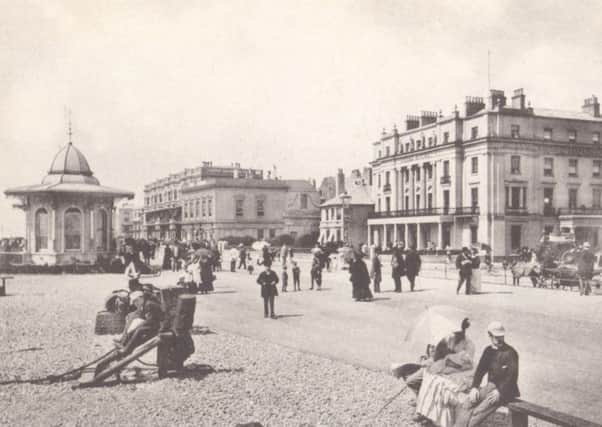Wicks Original Royal Baths and the County Club


Today Connaught House stands there, with the Connaught Leisure amusement arcade on the ground floor and the Occasions night-club above.
The first building on the site, erected in 1797, was Wicks Original Royal Baths, a curious-looking wooden structure that jutted out from the line of the other buildings along the esplanade – as did its successor.
Advertisement
Hide AdAdvertisement
Hide AdJohn Wicks’s baths were the first baths in Worthing, and they remained the only baths in the town until, in 1818, Thomas Trotter, the proprietor of the Theatre Royal in Ann Street, built the Royal Baths – a building later known as Marlborough House – some 230 yards to the west, on the corner of a street that no longer exists, called Paragon Street.
The erection of Worthing’s first bath-house was an important step in the transformation of the town from a straggling village to a thriving Georgian seaside resort, and in ‘A Guide to All the Watering and Sea-Bathing Places’, published in 1803, John Feltham writes: “The erection of a very commodious warm baths (Wicke’s [sic]) sufficiently prove how far Worthing has risen in public estimation.”
John Evans, author of ‘A Picture of Worthing’, published in 1805, gives a little more detail about Wicks’s bath-house: “There is also a warm bath, belonging to Mr John Wickes [sic]; it has been lately erected and is heated to whatever temperature may be required; thus the benefits of hot and cold bathing, so much insisted on by the faculty [that is, the medical profession] may be enjoyed in perfection.”
In the 1813 and 1817 editions of ‘A Sketch of Worthing’, John Mackoull provides one further detail, telling us that there were “five hot and cold baths” at Wicks’s establishment.
Advertisement
Hide AdAdvertisement
Hide AdOne notable visitor to Wicks’s‑ baths, eight years after it opened, was Jane Austen’s elder sister, Cassandra, who patronised it on September 20, 1805.
This was during her and Jane’s stay in the town at the end of 1805, which was later to provide the novelist with the inspiration for her final, unfinished novel ‘Sanditon’.
In 1829, the original bath-house was demolished, and replaced by a new building, which went under the grander title of the New Parisian Baths.
As part of the process, the proprietor, by now a man called Mark Markwick, was given permission to build a tank 17 feet by 12 feet in front of the building, under the seafront esplanade.
Advertisement
Hide AdAdvertisement
Hide AdMarkwick came to an unusual arrangement with the Town Commissioners – namely that “a cast iron tube to allow the escape of foul air” from the tank would also be “used by the Commissioners for a lamp post”!
Although the New Parisian Baths was presumably an improvement on its old-fashioned predecessor, it did not remain in business for long, closing after just eight years.
The building had a number of uses after that, including as a shop known as the Pier Bazaar; and this was its use when the etching and two of the photographs reproduced on these pages were first published.
The etching shows the building with a pitched roof, but this may have been artistic licence, since the two photographs of the same period do not have this.
Advertisement
Hide AdAdvertisement
Hide AdThe Pier Bazaar closed in 1888 and the building, by now numbered No. 35 Marine Parade, briefly became the Parade Restaurant.
Then, from 1891 to 1934, it was a gentlemen’s club called the County Club.
This seems to have been a provincial version of the gentlemen’s clubs to be found in the West End of London. It had a dining-room, and presumably a bar and a smoking-room.
There would probably have been a billiards room too, and possibly a library.
Advertisement
Hide AdAdvertisement
Hide AdIt has proved very difficult to discover anything further about the County Club – the fact that its secretary in 1910 was one H. N. Collet is not perhaps of overwhelming interest – and I would be glad to hear from anyone who knows anything more about it.
Perhaps the father or grandfather of a Herald & Gazette reader was a member, and sometimes spoke of it?
After the club closed in 1934, the building was demolished and replaced the following year by Connaught House, built in complementary style to the Royal Arcade, which had been erected ten years earlier on the site of the Royal Hotel.
Connaught House was the first building on the site to be in line with the other buildings on Marine Parade, rather than jutting out onto the esplanade.
• Antony Edmonds is the author of Jane Austen’s Worthing: The Real Sanditon (Amberley, 2013). The picture of Wicks Original Royal Baths is reproduced by courtesy of Worthing Museum and Art Gallery.